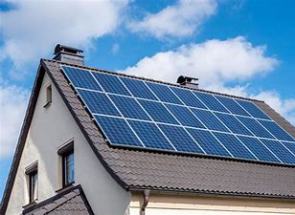Photovoltaic Solar Panels
Solar Photovoltaic (PV) cells are made from layers of semi-conducting material, usually silicon, sandwiched between a sheet of glass and a polymer resin. When light shines on the material, electrons are dislodged, thereby creating a flow of electricity. The cells don’t necessarily need direct sunlight to work. In fact they can even work on a cloudy day. However, the stronger the sunshine and the more perpendicular the sun’s rays are to the surface of the panel, the more electricity generated.
Solar PV cells are grouped into modules, and modules are usually grouped into solar arrays. Modules and arrays come in a variety of shapes and sizes. Most PV systems are made up of panels that fit on top of your roof, but you can also install them on special brackets on the ground or on flat roofs. A 4kW system suitable for an average house will occupy about 30 square metres of the roof.
The electricity generated from solar panels is direct current (DC), whereas the electricity you use for household appliances is alternating current (AC). An inverter is therefore installed along with the system to convert DC electricity to AC.
The economic benefits of solar panels
Powering your home with solar energy is the world's fastest growing renewable energy solution and could see savings of up to £500 a year on your electricity bills by installing solar panels and battery storage depending on the level of insulation in your property.
Having solar panels on your roof also allows you to become more independent from the National Grid, reduce your home's impact on the environment and have greater control over how and when your energy is used. You can also earn money for exporting excess solar energy generated by your solar panel system back into the grid assuming your installation includes batteries.
The price of solar panels has steadily decreased over the years as experts have continually been discovering ways to make solar energy components more efficient. A 4kW solar panel system would be enough for the electricity needs of an average UK home. It has an output of 3,400 kWh per year, costs around £8,000 and covers roughly 30 m² of your roof. In order to maximize the efficiency of your system it is worth considering installing batteries for about an extra £5000. When choosing solar panels it is always worth comparing different manufacturers as the characteristics of their products can vary considerably.
Generally speaking photovoltaic panels can expect to lose their efficiency by about 5 - 10% per annum which means that the life expectancy of current photovoltaic panels is about 15 - 20 years.
Planning considerations
In a conservation area, the installation of solar panels on a roof will normally require planning permission and is not regarded as permitted development.
One of the major concerns in a conservation area is to preserve the appearance of the buildings, particularly as they are viewed from the road. When considering the possible installation of solar panels it is worth considering whether solar panels can be installed on roof surfaces that are not visible from the road. For instance, it may be possible to install them in a valley, or on a flat garage roof or even on the ground in the back garden on special frames.


